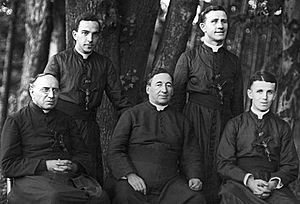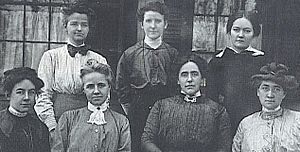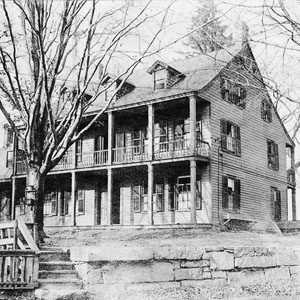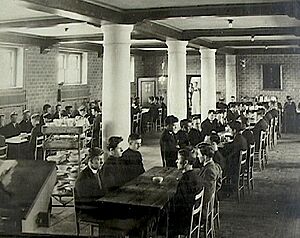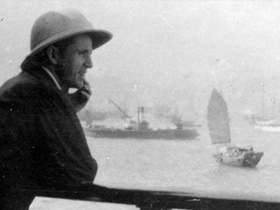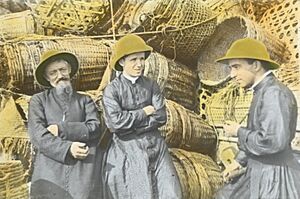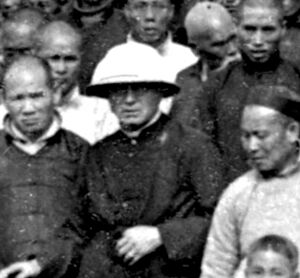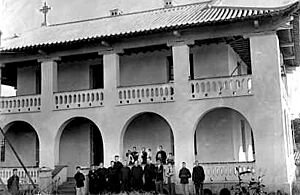Maryknoll Society facts for kids
The Maryknoll Society is a Catholic group for men founded in the United States. Its main goal is to send missionaries to help people who are poor or struggling around the world. They are also known as the Maryknoll Fathers and Brothers.
The society was started in 1911 by three people: Thomas Frederick Price, James Anthony Walsh, and Mary Joseph Rogers. The name Maryknoll comes from a hill in New York, where their main office is located. People who are part of this group are often called Maryknollers.
Maryknollers are sometimes called the "Marines of the Catholic Church." This is because they are known for going into difficult areas. They live alongside local people and learn their languages. Maryknollers work to "fight poverty, provide healthcare, build communities, and promote peace and fairness." They have built many orphanages and schools in the countries they serve. Maryknoll is also seen as a movement that helps local people through positive actions.
Two other groups, The Christophers and The Maryknoll Affiliates, are connected to the Maryknoll Movement. Maryknoll is also the name of a magazine published by the Maryknoll Fathers and Brothers.
The name Maryknoll is shared by other Catholic groups, like the Maryknoll Sisters and the Maryknoll Lay Missioners. These groups are separate but work closely together. They all focus on overseas mission work for the Catholic Church, especially in East Asia, the United States, Latin America, and Africa.
Contents
History of Maryknoll
How Maryknoll Started
Before 1906, the Vatican considered the United States a "mission territory." This was a time when many European Catholics were moving to the U.S., and there was some unfriendliness towards Catholics. Maryknoll was created for foreign missions when the Catholic Church was focusing on this issue within the United States. At that time, only a small number of American Catholic priests served in foreign missions.
In 1907, Father James Walsh started a magazine called The Field Afar. This magazine later became Maryknoll. The next year, Mary "Mollie" Josephine Rogers began helping Walsh with the magazine.
In 1910, Father Thomas Price was trying to start a Catholic group for mission work in the South. He found it hard to raise money while also doing his mission work. Price and Walsh met at a conference and immediately began planning a national seminary for foreign missions. They worked well together: Walsh was good at organizing, and Price was friendly and inspiring.
Founding the Maryknoll Fathers and Brothers: 1911–1919
The two priests traveled to Rome, where Pope Pius X gave them permission to start their new society on June 29, 1911.
Walsh quickly put an advertisement in The Field Afar. It asked for young men who wanted to work for people in other lands, even if it meant no earthly rewards or guarantee of returning home. In 1912, the Catholic Foreign Mission Society of America (CFMSA) began in a rented building in Hawthorne, New York. Six men joined the group. Thomas McCann was the first to become a full brother member of the Maryknoll Society in November 1912.
That September, Rogers moved to New York to continue working on the magazine. She and five other women, who were "secretaries," started living together. Rogers became their leader. She believed the women could be missionaries themselves, not just helpers for the men.
"Mary's Knoll" and the Teresians
Walsh and Price immediately looked for a permanent home for their new society. They tried to buy land in Pocantico Hills in July 1912. However, John D. Rockefeller, who owned nearby property, did not want a seminary as a neighbor. He challenged the purchase in court. In August, CFMSA gave up the land in exchange for money. Walsh and Price then found a 93-acre hill in Ossining. It had three houses and a barn and was now affordable because of the money they received. To avoid another problem, Rogers, dressed as a "Lady from Boston," and a lawyer handled the sale. Walsh, pretending to be her driver, waited in the car.
They bought the property on August 20, 1912, for $44,500. Price dedicated the land to the Blessed Virgin Mary, and the name "Mary's Knoll" was created. The hilltop had two homes. The larger one became the first Seminary, and the other was for the "secretaries." A carriage house was turned into a chapel. The barn was used by the brothers and seminary students.
A few weeks later, Walsh asked the "secretaries" how they wanted to be organized after moving to Maryknoll. They had been paid for their work, and Walsh promised to continue this. But he asked if they wanted to continue as laywomen or become a community living under religious promises. All the women agreed. Rogers told her colleagues, "I want you to know how wholly I belong to you... to serve you, to love you, to watch over you."
On October 15, 1912, the women joined Rogers, who had moved to Maryknoll earlier to cook and help organize. They called their building "St. Teresa's Lodge." A traveling priest sent a postcard addressed to them as the Teresians, and the name stuck. The Teresians began studying as they planned to ask Rome for official recognition.
Maryknoll now had nine men serving as brothers, in addition to McCann. They named their building "St. Michael's" Residence and called themselves "The Brothers of St. Michael." Like the Teresians, most brothers spent their early years building and maintaining the Maryknoll buildings.
Michael Hoban, the bishop of Scranton, Pennsylvania, invited Maryknoll to open a school there. In 1913, Maryknoll Preparatory Seminary was founded. Students attended classes at St. Thomas College. Raymond Lane, one of the first students, wrote that the school's success was due to the people of Scranton. They supported the seminary with meals, transportation, and donations. In 1915, the lease ended, and students joined the community outside Ossining for a year. In 1916, Walsh bought 179 acres in Clarks Summit, PA. A school was set up in an old farmhouse on the property. It became known as the Venard. Price was in charge of the Venard its first year.
First Missions to China
World War I ended in 1918. Three Maryknoll priests were ready for the first Maryknoll mission to China. James Edward Walsh, Francis X. Ford, and Bernard F. Meyer, along with Price as their leader, left for China on September 7, 1918.
Walsh and Meyer arrived first, with Price and Ford following weeks later. Their first stop in Asia was Hong Kong. They spent time there with another Catholic group to get used to the area. From Hong Kong, they went to Yeungkong and began their missionary work in China. Even though he only learned a few words of the local languages, Price quickly set the example for the mission. He focused on helping the common people. He took every small act of service seriously, from church services to visiting villages. He planned for their needs, even if plans couldn't happen right away. He was patient and polite to every visitor. He made sure his mission and all his energy were completely dedicated to serving the people.
Daniel Leo McShane led the second group to China in 1919. McShane's first job was to help Meyer. When the Maryknollers arrived, they found that Chinese orphanages did not accept babies or sick children. So, an orphanage was started in Yeungkong in 1920. McShane then went to Luoding and immediately set up another orphanage for abandoned children there, even though some local people were against it. Most of the abandoned babies were girls. Traditionally, they were drowned. The Maryknollers built facilities and offered a few cents for every child. Soon, the Yeungkong orphanage was baptizing about 450 infants a year, and the Luoding facility nearly a thousand.
Death of Founder Thomas Price: 1919
In August 1919, Price became very sick. There were no good medical facilities nearby, so he was taken to St. Paul's Hospital, Hong Kong. It was a long and difficult journey from Yeungkong. Price was admitted on August 19, 1919, and had an operation in early September. The treatment was too late, and Price died from a burst appendix on September 12, 1919. He was buried in Hong Kong. In 1936, his body was moved to the cemetery at Maryknoll, New York. James E. Walsh became the leader of the mission after Price's death.
Maryknoll Today
As of 2008, there are over 475 Maryknoll priests and brothers serving in countries worldwide. They mainly work in Africa, Asia, and Latin America. Throughout their history, especially in the first half of the 20th century, Maryknoll missionaries played a big role in the Catholic Church in East Asia. Some missionaries still work there. Maryknoll also has strong connections with many Latin American countries. They have long worked to help reduce poverty and bring positive changes to the lives of poor people in Latin America.
Maryknoll Seminary Building
The Maryknoll Seminary Building is in Ossining, New York. This building is now the main office for Maryknoll missions. The building has a special design, including pagodas. This design honors its original purpose as a mission group focused on the Far East.
Maryknoll Martyrs
- Francis Xavier Ford: Fr. Ford was one of the first four Maryknollers to arrive in China in 1918. He died in a prison in Canton in 1953. A primary school named Bishop Ford Memorial School was founded by the Maryknoll Fathers in Hong Kong in 1952. The school is now run by the Catholic Diocese of Hong Kong.
Other Notable Maryknollers
- Everett Francis Briggs: A Maryknoll missionary who studied the history of the Monongah Mining Disaster of December 6, 1907. This was called "the worst mining disaster in American History." He worked to make sure the victims were not forgotten.
- Miguel d'Escoto Brockmann: He served as the Foreign Minister of Nicaragua in the Sandinista government.
- Patrick Joseph Byrne: He was a special representative of the Pope to Korea from 1949 to 1950. He died while held by Communists in Korea.
- Fr. Vincent R. Capodanno: A former Maryknoll missionary and Servant of God. He won the Medal of Honor during the Viet Nam War as a Navy Chaplain with the US Marines. He did his missionary work in Taiwan.
- Fr. Robert W. Greene: He served in China. He was placed under house arrest in 1950 and later forced to leave China in 1952. He wrote a book about his experiences called "Calvary in China."
- Fr. Joseph G. Healey: He serves in Kenya. He is known for using proverbs and other local stories in his ministry.
- James Keller: He founded The Christophers, a group that encourages people to make a positive difference in the world.
- Thomas Melville: A former Maryknoll priest and Catholic activist. He was one of the "Catonsville Nine," a group of activists who protested the Vietnam War.
- Bishop Adolph John Paschang: A Maryknoll missionary. A primary school named Bishop Paschang Memorial School was set up in Hong Kong in 1969. The Maryknoll Fathers still run this school.
- Thomas Frederick Price: One of the two Maryknoll founders. He was one of the first four Maryknollers to arrive in China in 1918. Price Memorial Catholic Primary School was founded in Hong Kong in his honor.
- Bishop James E. Walsh: A Maryknoll missionary. He was one of the first four Maryknollers to arrive in China in 1918. He became a bishop in 1927. He was imprisoned in 1959 and released in 1970. He was the last American missionary released by the Communist Chinese government. A primary school named Bishop Walsh Primary School was set up by the Maryknoll Fathers in Hong Kong in 1963. The school is now run by the Catholic Diocese of Hong Kong.
Schools in Hong Kong
Several well-known schools in Hong Kong were started by Maryknollers. Some are still run by them today.
Schools Founded by Maryknollers
- Bishop Ford Memorial School: A primary school for boys and girls. This was the first school founded by the Maryknoll Fathers in Hong Kong after Second World War. It was started in 1952, named after Fr. Francis Xavier Ford. The Catholic Diocese of Hong Kong now manages this school.
- Kwun Tong Maryknoll College: A secondary school for boys, now managed by the Catholic Diocese of Hong Kong.
- Bishop Walsh Primary School: A primary school for boys and girls. This school was founded in 1963, named after Bishop James Edward Walsh. The Catholic Diocese of Hong Kong now manages this school.
- Pope Pius XII Primary School: A primary school for boys and girls in Hong Kong, founded in 1953 and closed in 1979. Its legacy is continued by Chai Wan Kok Catholic Primary School and Sham Tseng Catholic Primary School, both now run by the Roman Catholic Diocese of Hong Kong.
- St. Patrick's School: A primary school for boys and girls, now managed by the Catholic Diocese of Hong Kong.
- St. Patrick's Catholic Primary School (Po Kong Village Road): Also a primary school for boys and girls, now managed by the Catholic Diocese of Hong Kong.
- Marymount Secondary School: A secondary school for girls founded in 1927. This was the second school started by Maryknollers in Hong Kong.
- Marymount Primary School: A primary school for girls.
- Maryknoll Convent School: A primary and secondary school for girls.
The last three schools were actually founded by the Maryknoll Sisters. Maryknoll Convent School is still managed by them in Hong Kong. However, the two Marymount schools are now sponsored by another group. Still, these three schools are often seen as part of the Maryknoll family in Hong Kong.
The first school managed by the Maryknollers in Hong Kong was called St. Louis Industrial School (1921-1927). The first school founded by Maryknollers in China was St. Thomas School, a primary school in Yangjiang.
Schools Still Run by Maryknoll Fathers and Brothers
- Maryknoll Secondary School: A secondary school for boys and girls.
- Maryknoll College (Senior Form): A private evening school for older students.
- Maryknoll Fathers' School secondary section: A secondary school for boys and girls.
- Maryknoll Fathers' School (Primary Section): A primary school for boys and girls.
- Bishop Paschang Catholic School: A primary school for boys and girls. This school was named after Bishop Adolph John Paschang.
See also
 In Spanish: Maryknoll para niños
In Spanish: Maryknoll para niños
- Catholic Church in China
- Catholic Church in Japan
- Catholic Church in Korea
- Consecrated life
- Dalian Catholic Church
- Institute of consecrated life
- Roman Catholic Diocese of Jiangmen
- Secular institute
- Society of apostolic life
- Maryknoll House (Stanley)



